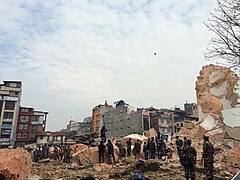Dharahara
| Dharahara | |
|---|---|
धरहरा | |
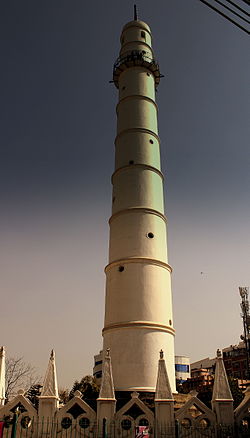 Dharahara in 2013 | |
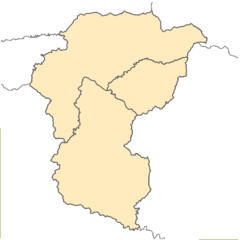 Location within Kathmandu valley | |
| Alternative names | Bhimsen Tower |
| General information | |
| Status | Complete (Reconstructed) |
| Architectural style | Mughal and neoclassical style |
| Location | Sundhara, Kathmandu, Nepal |
| Country | Nepal |
| Coordinates | 27°42′03″N 85°18′43″E / 27.7007°N 85.3119°ECoordinates: 27°42′03″N 85°18′43″E / 27.7007°N 85.3119°E |
| Completed | 1832 or later |
| Destroyed |
|
| Height | 72 metres (236 ft) |
| Design and construction | |
| Architect | Bhimsen Thapa |
Dharahara (Nepali: धरहरा; pronounced [dʱʌɾʌɦʌɾa] or [dʱʌɾʌːɾa]), also called Bhimsen Sthambha (Nepali: भिमसेन स्तम्भ), is a twenty two-storey, 72-metre-tall (236 ft)[1] tower at the centre of Sundhara, Kathmandu, Nepal.[2] It was first built in 1832 by Mukhtiyar (equivalent to Prime Minister) Bhimsen Thapa under the commission of Queen Lalit Tripurasundari and was a part of the architecture of Kathmandu recognized by UNESCO.[3] It has been damaged and reconstructed several times.
The tower had a spiral staircase containing 213 steps. The eighth floor held a circular balcony for observers that provided a panoramic view of the Kathmandu valley. It also had a 5.2-metre (17 ft) bronze mast on the roof.[2]
Most of the tower collapsed in the 25 April 2015 Nepal earthquake, but the base remains.[4][5]A total of 180 bodies were retrieved from the debris of tower after earthquake.[6] Reconstruction of the tower commenced in October 2018, and it was officially opened on 24 April 2021, one day before the sixth anniversary of the earthquake.[7]
History[]

Dharahara in Kathmandu was the tallest building in Nepal and the second such tower built by Bhimsen Thapa.[8] The first tower was built eight years earlier in 1824 (1881 BS) at his residence, Janarala Bagh, situated at south-east of Sundhara, near Bhotebahal of Kathmandu.[9] It got torn in half during the earthquake of 1834 and was never rebuilt. It was only a year later (in 1835) that Bhimsen Thapa built the second Dharahara, along with the Sundhara (the golden water spout), for Queen Lalit TripuraSundari Devi, who was the niece of Bhimsen Thapa.[9][10]
A century later, on 15 January 1934, another earthquake completely destroyed the first tower, and only two of the nine storeys of the second tower remained. The then Prime Minister of Nepal, Juddha Shumsher Jang Bahadur Rana, subsequently carried out renovation work of the Dharahara tower to fully restore it.[3] After the original Bhimsen Tower was destroyed, Queen Lalit Tripurasundari's tower came to be known as Bhimsen Stambha (Nepali: भिमसेन स्तम्भ, lit. 'Bhimsen Tower').
The second tower was built in honour of Bhimsen Thapa's feat of taking Nepal's land back in the war. King Rajendra Bikram Shah had given a lalmohar (a document with the royal seal) to Bhimsen Thapa in 1835, acknowledging his Commander-in-Chief status and building of Dharahara in Sundhara in 1824, in his honour.[9]
Dharahara was constructed for military usage as a watchtower. When incidents of national importance occurred, bugles were blown from the top floor of the tower. This was the signal for soldiers to assemble. This tradition of bugle trumpeting continued until the collapse of the tower.[2][11] On one of the sign board at Dharahara, it is stated that the Dharahara's main purpose was to enable the state and city authorities to summon people to gather on the Tundikhel (the military parade ground to the northeast of the tower) to hear government announcements, and that it showed ‘the religious harmony between Hindu, Muslim and Christian faiths.'[12]
Amongst the many myths Kathmandu is surrounded by, the most famous and fearsome Rana Prime Minister of Nepal, Jung Bahadur Rana. Legends has it that "The White Tiger" rode on a horse back and climbed upstairs to the balcony of the tower. What he did next was daring to many and plain stupid to some. He jumped off the balcony on the horseback! The horse died from the jump but "Jungey" survived. One of his daring acts among many.[13]
2015 earthquake[]

On 25 April 2015, at 11:56 NST, an earthquake with an estimated magnitude of 7.8 (Mw), hit Kathmandu and its surrounding region, leading to the collapse of the tower.[5] The earthquake's epicenter was approximately 29 kilometres (18 mi) east-southeast of Lamjung, Nepal.[4] The structure collapsed and only its base survived.[14][15][16] According to the people on the scene when the earthquake hit, the region was covered with clouds of smoke and the rubbles heard shouting. The Nepalese Army barricaded the entrance and launched the rescue mission. Some people were able to collect the remains of Dharahara bricks, probably to remember them. Those bricks were inscribed with the name of Juddha Shumsher, indicating that the tower was rebuilt during his tenure.[13] More than 9,000 people were killed and 2.8 million were displaced. The image of Dharahara that fell during the earthquake in the 19th century, quickly became an iconic representation for many Nepalese not only of the catastrophe but also of their national determination to recuperate and rebuild it.[12] When local people living far away from the epicenter heard that the Dharahara had fallen that they understood the scale of the calamity: they then realised that ‘the disaster was not small’. It was a total shock for Nepal and entire Nepalese people, regardless of their ethnicity, caste or gender, because Dharahara was the pre-eminent symbol of their capital city's, and therefore their nation's identity.[12]
In February 2016, the government decided to rebuild the tower, and Prime Minister KP Sharma Oli and his cabinet ministers contributed one month's salary to the rebuilding. A fund called "I will construct Dharahara" was also established to collect money for the reconstruction. According to Sushil Gyawali, chief executive of the National Reconstruction Agency, the new tower will be earthquake-resistant.[17] The foundation stone of the new tower was laid down on 27 December 2018.[18]
Reconstruction and inauguration[]
The original one, built by the first prime minister of Nepal Bhimsen Thapa, was destroyed in the 1934 earthquake. Rana Prime minister Juddha Sumsher Rana reconstructed it which was destroyed by the April 2015 earthquake. Under the coordination of the National Reconstruction Authority, the Reconstruction of the monument took place.
The inauguration ceremony was organized on the eve of the sixth memorial day of the Gorkha earthquake which occurred on April 25, 2015. Reconstruction of the tower had begun in October 2018. Prime Minister KP Sharma Oli inaugurated the historical Bhimsensthmbha (Dharahara) on April 24, 2021 in Sundhara, Kathmandu.[7]
Architecture[]
The architecture of Dharahara is designed in both Mughal and European style. It is widely believed that the original towers were modelled on monuments in India such as the minarets that stand at the four corners of the Taj Mahal complex at Agra, or the Qutb Minar in Delhi.[12] BhimsenThapa was a known admirer of the Mughal style as is evident by his palace, now demolished, which was Mughal in style with a fair amount of Kathmandu Gothic thrown in. The main materials used in the tower construction were Vajra-Surki (Brick dust), Chuna (Lime), Maas (Black lentil) and Chaaku (Caramel). The combination of these materials are considered to be much stronger than the common cement used nowadays.[13]
Before collapse[]
The tower was a major tourist attraction and was open to the public from 2005 until its collapse in 2015. The management of Dharahara before 2015 came under heavy scrutiny from locals and tourists. The Heritage Department of Kathmandu Metropolitan City was criticized for its lack of effort to protect the heritage site.[19]
New Tower[]
On April 24, 2021, Prime Minister of Nepal officially inaugurated the opening of new replica Dharahara Tower which is built just at the side of old tower remains. The new tower stands 72m high (236ft) tall with 48ft foundation and has 22 storey. Just like old tower, It also has gajur (bronze mast) on its top roof. It also has a museum, a garden and a fountain nearby its surrounding. It has two lifts with underground parking with capacity to accommodate 350 four-wheelers and 6,000 two-wheelers[20] to make it more accessible. The tower is shaped like a minaret and offers views across the Kathmandu Valley. However, visitors will have to wait until later in the year to enjoy them, as there will be no access for the public until November.[21] The total cost of the new tower is estimated to be at 3.48 billion Nepalese Rupees. [22]
Gallery[]

The original Dharahara before the 1934 earthquake
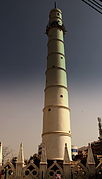
Dharhara before the 2015 earthquake
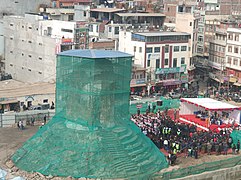
The remains of Dharahara preserved under safety netting
Evacuation from under the rubble of Dharahara after the 2015 earthquake

The remains of Dharahara after the 2015 earthquake

The remains of Dharahara after the 2015 earthquake

Prime Minister KP Sharma Oli laying the foundation stone for the reconstruction of Dharahara on 27 December 2018
See also[]
| Wikimedia Commons has media related to Dharahara. |
References[]
- ^ "In pictures: Earthquake in Nepal demolishes Darahara Tower". DNA. Retrieved 25 April 2015.
- ^ a b c "Bhimsen Tower on LonelyPlanet Guide". The Lonely Planet. Retrieved 2011-12-14.
- ^ a b "For Sale". The Kathmandu Post. 3 May 2013. Archived from the original on 24 September 2015. Retrieved 25 April 2015 – via HighBeam.
- ^ a b Deepak Nagpal (25 April 2015). "LIVE: Two major quakes rattle Nepal; historic Dharahara Tower collapses, deaths reported in India". Zee News. Retrieved 25 April 2015.
- ^ a b "Historic Dharahara tower collapses in Kathmandu after earthquake". DNA India. 25 April 2015. Retrieved 25 April 2015.
- ^ "180 bodies retrieved from debris of Dharhara tower". The Hindu. PTI. 2015-04-25. ISSN 0971-751X. Retrieved 2021-06-28.
{{cite news}}: CS1 maint: others (link) - ^ a b "Nepal opens replica Dharahara Tower in Kathmandu". BBC News. 2021-04-24. Retrieved 2021-04-25.
- ^ "Too tall for comfort". The Kathmandu Post. 11 January 2010. Archived from the original on 24 September 2015. Retrieved 25 April 2015 – via HighBeam.
- ^ a b c "The tale of two Dharaharas destroyed by two earthquakes at a 100-year interval". OnlineKhabar English News. Retrieved 2021-06-28.
- ^ Melissah Yang (25 April 2015). "Nepal Earthquake Destroys Dharahara Tower, A Significant Tourist Attraction In The Heart Of Kathmandu". Retrieved 25 April 2015.
- ^ "Quake turns two historic landmarks in Kathmandu into rubble". Hindustan Times. 25 April 2015. Archived from the original on April 26, 2015. Retrieved 25 April 2015.
- ^ a b c d Hutt, Michael (2019). "Revealing What is Dear: the post-earthquake iconisation of the Dharahara, Kathmandu" (PDF). Journal of Asian Studies.
- ^ a b c "The Darling Tower of Kathmandu: Dharahara". HoneyGuide. 2015-05-17. Retrieved 2021-06-28.
- ^ "Nepal earthquake topples historical Dharhara tower". Khaleej Times. Retrieved 25 April 2015.
- ^ "Historical Bhimsen Tower (Dharhara) in Kathmandu destroyed in earthquake". World Snap. Retrieved 25 April 2015.
- ^ Robert Midgley (25 April 2015). "19th century tower collapses from earthquake in Nepal". The Telegraph. AP. Archived from the original on 25 April 2015. Retrieved 26 April 2015.
- ^ "Nepal To Rebuild Historic Dharahara Tower On Its Own". NDTV. 16 February 2016. Archived from the original on 18 February 2016.
- ^ "PM Oli lays base for Dharahara amid cultural activists' protests". kathmandupost.com. Retrieved 2020-07-08.
- ^ "It speaks of history, but the glory is lost". Kantipur News Daily. 17 December 2010. Retrieved 26 April 2015.
- ^ Samiti, Rastriya Samachar (2021-04-20). "Reconstructed Dharahara to be inaugurated on April 24". The Himalayan Times. Retrieved 2021-06-28.
- ^ "Nepal opens replica Dharahara Tower in Kathmandu". BBC News. 2021-04-24. Retrieved 2021-06-28.
- ^ "Dharahara construction in final stages". kathmandupost.com. Retrieved 2021-06-28.
- Towers in Kathmandu
- Towers completed in 1832
- Tourist attractions in Kathmandu
- Bhimsen Thapa




